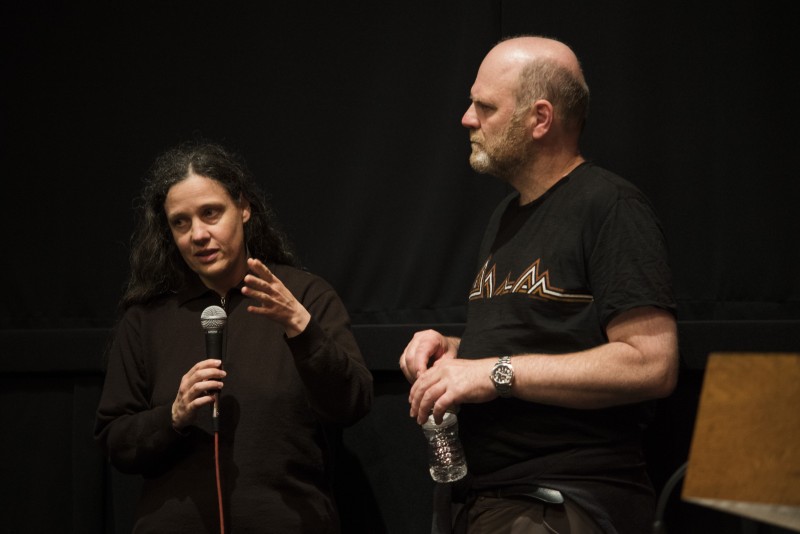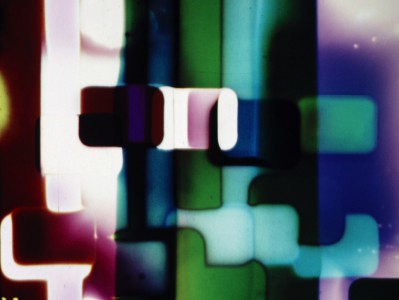
Alchemy and Apparatus . The Films of Richard Tuohy and Dianna Barrie
Screening on Film
$12 Special Event Tickets
Instead of annihilating film, the rise of digital cinema seems to have created a subspecies that is flourishing in this new, altered environment. Around the world, an ever-increasing number of artist-run film labs are organizing and proliferating. They are feeding off of the machines that studios, schools and commercial laboratories discarded, and often reengineering them to suit the hybrid post-digital present. These artists and collectives are still reliant upon Kodak, yet more and more self-sustaining and inventive. Many experimental filmmakers, forces now joined, are invigorated by this accessible, communal command of an “obsolete” medium.
Central to this ingenious web are Australian filmmakers Richard Tuohy (b. 1969) and Dianna Barrie (b. 1972). Residing in Daylesford just outside of Melbourne, Tuohy and Barrie make films together, founded and run Nanolab—part commercial Super 8 lab, part alchemical artist playground—and established the Artist Film Workshop, a cooperative, members-run lab in Melbourne. As part of the generous “open-source”-oriented end of the artist-run lab scene, Tuohy and Barrie travel the world setting up or assisting other labs and, in cases like Boston’s own AgX Film Collective, inspiring their founding. They repair machines, retrofit them with devices of their own design, and hold workshops on alternative processes—guiding filmmakers closer to the means of production and encouraging the kind of experimentation and curiosity that permeates their own work.
As with many brilliant inventions, Nanolab was born out of necessity and desperation: the end of Kodak’s iconic Kodachrome stock loomed, and no lab that could process the new Ektachrome stocks existed on their continent. As a result, Tuohy and Barrie are now thoroughly immersed in every step of the filmmaking process—shooting, processing and printing both the picture and the optical audio tracks. Their boundless creativity and wizardry extend to all the chemical, electrical and mechanical operations of the various cinematic contraptions and procedures.
This deep level of involvement viscerally informs their finished works. As Tuohy explains, it is “important to be able to dwell with your tools, as an artist.” Tuohy and Barrie’s shared backgrounds in philosophy perhaps influence the result: a unity of form and concept seamlessly synthesized into a satisfying whole. Particularly in their expanded, multi-projector pieces, the works seem nearly sculptural in their physical presence.
Their relationship with film feels intimate and complete, a kind of closeness unimaginable in the digital realm. Film’s physicality, Tuohy notes, “means that you can look at it and understand how it works. I think analogue has a greater potential to tell us about ourselves… We can see what it’s doing and feel it,” whereas digital is so complex that an artist generally has to manipulate at a “software level.” In many of their pieces, Tuohy and Barrie play with the “humanness” of analogue machines and the mechanization of civilization—breaking up images and action into alternate order, sequences, layers, pieces. Something old, something new. “I use the philosophical term ‘emergent phenomena.’ I like to think of creating situations where new phenomena will emerge from the apparatus. Maybe you weren’t expecting that, or the audience wasn’t, but this tells us about the apparatus of cinema.”
This fundamental kineticism variously satisfies or disrupts the body’s communication with the mind, amplifying the viewer’s total engagement to the cellular level and beyond. The many stages of discovery and transformation extend to the content—as when they document modern patterns of existence—which they often seem to approach with both awe and critique. Naturally, the filmmakers are more interested in presenting their dynamic transformations than interpreting them; perception and participation are left to the eyes of the respective beholders.
The Harvard Film Archive is thrilled to welcome Richard Tuohy and Dianna Barrie for one evening of their essential experimental cinema, including an expanded dual-projection performed live in our cinematheque! Reflecting their current worldwide travel schedule, their recent works are exquisite manifestations of their profound curiosity and engagement with the world through the endless mechanisms and marvels of film. – Brittany Gravely
Screens and partitions; windows and shutters; grids, curves and arches. Three peoples, one country: Malaysia.
Jakarta traffic moves with the harmonious chaos of complex self-organising entities everywhere. Through contact printer matteing techniques, this mass transport becomes denser and denser until only the fluid futility of motion/motionlessness remains. Jakarta traffic stands as proof of the paradox of motion.
Across the sea. Across the street. Cross-processed and grain-enlarged images of fraught neighbours Korea and Japan in a pointillist sea of grain.
Found in the (now possibly lost) film archive at Lab Laba Laba, footage from a trailer for the 1981 Indonesian propaganda film Kereta Api Terakhir (The Last Train) melts into a soup of “chemigrammed” perforations. A film about the silence that follows the unspeakable; about blurred visions, untold histories and inaccessible archives.
Hong Kong marked twenty years since its hand over; halfway through the planned forty-year “one country, two systems” transition. Taiwan, once imperial China, once Formosa, now ROC on the edge of the PRC. Multiple exposures of street scenes distort space and place creating a fluid sense of impermanence and transition, of two states somewhere between China and not China.
Architectural distortions of the second city.
Dot Matrix is dual 16mm projector expanded cinema film involving two almost completely overlapping projected images. The "dots" were produced by laying sheets of half-tone "dot" paper (used in manga illustrations) directly onto raw 16mm film stock, exposing the film through the paper with a flashlight and thus photographically transferring the dot images onto the film. These dots were then contact-printed with "flicker" (alternating black frames) creating strobing "interuptions." The drama of the film emerges in the overlap of the two projected images of dots. The product they make is greater than the parts. The sounds heard are those that the dots themselves produce as they pass the optical sound head of the 16mm projector.












